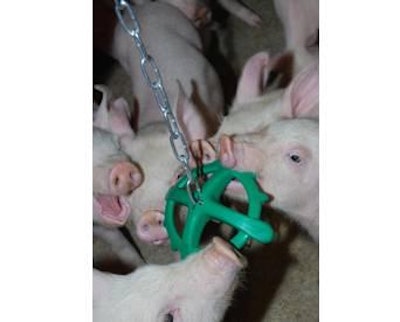
Tail biting is a major behavioral problem in pig production as it causes reduced pig welfare and considerable economic loss. Research shows that each pig with a bitten-off tail results in a loss of approximately 8 Euros (US$10). Although there has been much scientific and practical research, the problem still exists. Tail biting has several causes, such as vitamin shortage, competition for food, variation in housing climate and/or too many pigs in a small area. One of the greatest causes of tail biting, however, is boredom.
Tail biting is considered to be the result of a combination of factors, triggering a possible farm-wide outbreak; when at least one of the factors is reduced or eliminated, the outbreak is delayed or even stopped. One of the easiest ways to diminish tail biting is to prevent pigs from getting bored. Pigs are natural explorers, which means that when they are not sufficiently distracted, they may direct their attention to their pen mates. This can result in ear and tail biting, and this is where pig toys enter the picture.
From an early age, pigs have the natural tendency to chew. In addition, they undergo teeth changes between the age of 3 to 4 weeks, and again between 7 to 8 months of age. As the desire to chew during teething is a well-known trait in human babies, this is assumed to be the case with piglets as well. Furthermore, pigs are also attracted to blood. As soon as tail biting starts and bleeding occurs, immediate action must be taken.
European legislation on tail docking
In the past tail docking seemed to be the correct approach to prevent pigs from biting each other’s tails. More and more European countries, however, decided to ban tail docking in an attempt to create a better environment for pigs. Nordic countries, such as Finland, Sweden and Norway, even made it illegal to dock tails.
With the European Union Council Directive 91/630/EEG, as of January 2003, a minimum norm for the protection of pigs and pig toys came into effect. This directive sets guidelines, which every government can incorporate into its own legislation. This, however, creates a situation in which each European country has its own specific legislation on pig toys. Denmark, for example, stipulates partly organic, non-deformable, non-edible materials, such as soft PVC or wood. England stipulates deformable material. If it is of a material other than straw, hay, sawdust or turf, it may not touch the floor. In each country the legislation differs, which makes it complex for international producers of pig toys to make one toy that is legal and of interest to all European countries. But, as tail docking is becoming illegal in most countries, pig farmers seek other means to prevent the occurrence of tail biting; this explains why toys are increasingly attracting the attention of pig farmers.
Pig toys to prevent boredom
To help prevent pigs from turning to each other when bored, many farmers hang pig toys or bags of straw in the pens. The pigs find it interesting to chew and play with items dangling on a chain or rope. Some farmers even throw sawdust on the floor. Usually this works sufficiently if a good eye is kept on the behavior of the pigs so that the first stages of biting can be detected early. Something as simple as a new toy in the pen arouses the interest of the pigs in something else than each other, and biting can be reduced.
A disadvantage of using pig toys is the risk of creating an infection source. Normally pigs remain a few weeks in a pen, and as they grow they are placed in a larger pen. Before pigs are moved to another pen the compartment must be disinfected to avoid the spreading of diseases. It is therefore also very important that the toys be easily disinfected or that the toys are made from a material that kills the bacteria.
Pigs have an excellent sense of smell. A pig toy that emits a scent is an excellent means to keep a pig interested in the toy as the mere presence of a toy is not enough. A commercial toy, for example, is available that has a scent, which increases while the pig plays with it. This triggers the pig to be more curious as to where the smell comes from, thereby stimulating the pig to play with it longer. Interestingly, this toy is available in different scents such as vanilla, chocolate, apple, etc.
A new trend
Due to the illegality of tail docking and the upcoming interests of farmers in ways to prevent tail biting, pig toys are a new trend in pig production. Manufactures are continually innovating, which is necessary for optimal pig welfare and profit.

















